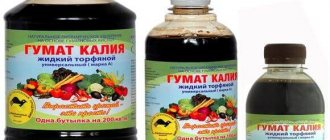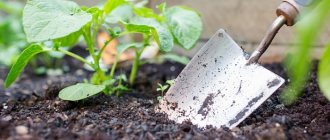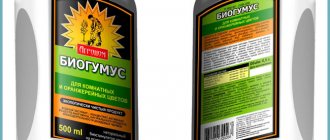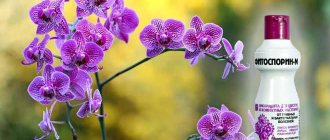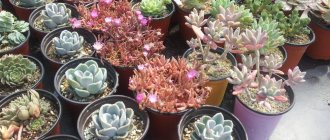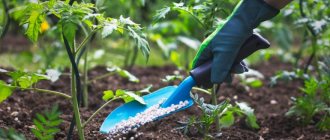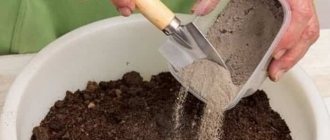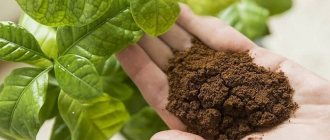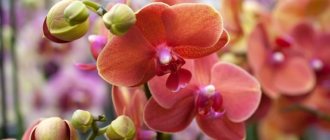582
Vermicompost is the best organic fertilizer, which has no analogues. This is an excellent growth stimulator without a single gram of chemicals. It has become popular among gardeners due to its rich range of beneficial properties and environmental friendliness. For ease of use, fermented and liquid types of vermicompost are available for sale, packaged in plastic bags or bottles of various sizes.
With the use of vermicompost, the yield increases by 30% or more
Liquid biohumus for the garden, seedlings and indoor plants is the primary fertilizer. It allows you to saturate the plantings not only with useful microelements, but also to stimulate the development of soil microflora. The instructions are simple and understandable to any gardener. This practical and practice-tested fertilizer, vermicompost, if desired, will not be difficult to make yourself.
Content
- Vermicompost: general definitions
- Vermicompost: purpose and methods of application
- Composition of vermicompost (vermicompost)
- Vermicompost: how it is obtained and release format
- How to use vermicompost
- a) Use of dry vermicompost
- b) Application of liquid vermicompost
- c) Application of vermicompost for individual plants
- About the safety of vermicompost
- Interesting fact: THE LARGEST BUYER OF VERBIHUMUS
- As a conclusion
Vermicompost increases the germination of seeds, activates the growth and development of plants, stimulates fruiting, saturates the soil with organic matter with a large set of microelements in a form accessible to plants, etc.
In this material we will summarize all the information related to the purpose and use of vermicompost. Let's consider not only its beneficial properties, but also its composition, features and standards of use, release format, etc.
How to use vermicompost for indoor plants?
For some unknown reason, liquid vermicompost is used for indoor plants. This is also called extracting: take dry vermicompost, fill it with water, and let it sit. Some of the microorganisms and bacteria, nutrients go into the water, and a significant amount of them - in vermicompost.
After this, liquid vermicompost is used for irrigation. Yes, from the point of view of marketing and sales - this is an excellent solution, the hood is over - you need to buy again.
When growing indoor plants, I use dry vermicompost, only the one obtained from the dendroben worm, without any further manipulation with it.
Vermicompost: general definitions
Vermicompost (vermicompost, from the Latin “vermi” - worms) is an environmentally friendly organic fertilizer, a product of processing organic matter (on an industrial scale, most often cattle manure) by a population of earthworms specially bred for this purpose. Of the total processing volume, the yield of commercial vermicompost is about 60%.
Vermicompost does not contain pathogenic microflora, helminth eggs, weed seeds and heavy metals. Despite the fact that it is an organic product, vermicompost does not have an unpleasant odor, its odor is neutral.
Vermicompost contains a unique community of microorganisms beneficial to soil and plants, which, when added to the soil, populate it, secrete phytohormones, antibiotics, fungicidal and bactericidal compounds, which leads to the displacement of pathogenic microflora. All this ultimately heals the soil and eliminates many widespread plant diseases.
The importance of vermicompost in organic farming can hardly be overestimated.
What is vermicompost?
This is the most valuable product of processing fresh manure by earthworms or specially bred breeds of worms. It is also called vermicompost. This process has developed in living nature: the worm absorbs the surrounding substrate, processes it into organic fertilizer, which is superior to artificial preparations in all respects. When processed by worms, manure is decomposed into amino acids, humic substances, and enriched with beneficial microorganisms and enzymes. During this processing, it is disinfected, loses its unpleasant odor, and takes on a granular form.
To prepare this fertilizer, special breeds of worms from the bristlecone order are bred: red Californian and Moscow hybrid. These worms are large in size and have a high rate of processing organic matter. You can also use ordinary worms, but their activity will not bring such quick results.
Production of organic fertilizer indoors
The formation of vermicompost occurs in two ways:
- in special closed composters;
- in open ground.
The main amount of processed organic matter is obtained by the second method, since the quality of the product is higher. It is easier to maintain the required temperature and humidity levels indoors, so this method of breeding is becoming more popular.
Vermicompost: purpose and methods of application
Vermicompost is intended to enhance the supply of nutrients to plants, enhance the activity of soil microflora, activate the synthesis of proteins, carbohydrates and vitamins in plants, increase the resistance of plants to temperatures, reduce the intake of radionuclides, heavy metals and pesticides into plants, enhance the growth and development of plants, accelerate ripening , increasing the yield and improving its quality.
Methods of using vermicompost:
- Vermicompost is a stimulant for soaking seeds for better germination.
- Vermicompost is an excellent component of nutritious soil for seedlings of vegetable and flower crops, as well as indoor flowers for their growth and development.
- Biohumus is an additive to the holes when planting seedlings in the ground, and when planting/transplanting seedlings of fruit and berry plants for their rapid adaptation.
- Vermicompost is feeding plants and improving soil health (open or protected), saturating it with organic matter and beneficial components.
Vermicompost is ideal for large plants and crops that require neutral acidity. But there are a number of nuances that you should know. For example, not all plants are responsive to the addition of vermicompost - sunflower, mustard, rapeseed, peas, soybeans, etc.
The use of vermicompost to improve fertility
Vermicompost is an excellent fertilizer that can improve the fertility of country, garden, arable and greenhouse lands.
After applying fertilizer, the result will be noticeable in the first year. Even on the poorest soils, yield increases by 20%. Nutrients will help plants grow and bear fruit for another 4 years.
Compared to manure, which is considered the best way to improve soil fertility, vermicompost is much more reliable for enriching land with useful substances.
Due to the rapid solubility of the components, plant roots will easily absorb all the useful elements.
But manure can also be made more suitable for enriching the soil; you just need to plant worms in it. This method of processing manure will help solve many problems:
- It will speed up waste disposal by turning manure into a quickly digestible fertilizer.
- Improves sanitary conditions around farms.
- Will reduce the number of weeds, since seeds passing through worms lose their viability.
- Recycled manure will increase crop yields.
- There will be no need to use chemical fertilizers that are harmful to health.
Just 3 tons of vermicompost applied to 1 hectare of land can 2 times enrich completely depleted soil.
How is it different from humus and humate?
Vermicompost is a fertilizer that is created in production from manure using special technology. For this purpose, manure, under special conditions, is processed by earthworms. The result is a concentrate that is mixed with soil 1:3.
Humates are salts: sodium humate and potassium humate, which themselves are formed in the ground as a result of the decomposition of plants. They, like vermicompost, are plant growth stimulants. Salts not only provide plants with nutrients, but also protect them from poisons and heavy metals that may end up in the soil.
Once in the soil, humates activate the “work” of microorganisms, thereby improving the structure of the soil and its breathability.
If we look at the difference between humates and vermicompost, we see that the former are produced naturally in the top layer of soil with the help of microorganisms and worms. And vermicompost is obtained with the help of worms when humans create special conditions.
Vermicompost differs from humus in that for humus, all plant residues, manure, chicken droppings, leaves, and sawdust are placed in a pit, which rot under the influence of putrefactive bacteria. It will take several years to form good humus useful for the earth. And vermicompost is immediately ready for use.
What is the difference between vermicompost and compost?
Compost is also obtained from plant residues, which are placed in a hole, sprinkled with ash and earth.
The difference between vermicompost and compost is that in the production of vermicompost, compost can also be used as a raw material. Worms are introduced into the compost and they turn the compost into vermicompost.
What is the difference between manure and vermicompost?
Manure does not benefit plants immediately, but only when it rots. Vermicompost is three times more effective than manure. The soil immediately receives useful substances, which are then absorbed by the roots of the seedlings.
Vermicompost contains more soil microorganisms, while manure contains much less. The microorganisms that fill vermicompost produce phytostimulants, antibiotics, and make phosphorus, potassium and other elements available for absorption by the roots.
With manure you can introduce weeds, harmful microorganisms, and various diseases into the ground. With vermicompost this is impossible.
Composition of vermicompost (vermicompost)
Vermicompost is a concentrated fertilizer containing a balanced complex of essential nutrients and microelements, enzymes, soil antibiotics, vitamins, plant growth and development hormones. It contains a large amount of humic substances.
Humic acids, fulvic acids and humins - this gives this organic fertilizer high agrochemical and growth-stimulating properties. The more humic components, the more nutritious the soil.
Composition of dry biohumus (vermicompost):
- moisture – 40-45%;
- ash – 35-45%;
- organic substances – 35-65%;
- humic substances – 20-32%;
- total nitrogen – 1.0-2.0%;
- total phosphorus (P2O5) – 0.9-3.0%;
- total potassium (K2O) – 0.9-2.0%;
- as well as beneficial natural microflora, phytohormones and vitamins, etc.
All nutrients are present in it in a balanced combination and in the form of compounds bioavailable to the plant. By the way, it should be noted that caprolites (the waste products of worms) glue the soil together into small lumps with the help of mucus, and this, among other things, allows the prolonged release of nutrients to the plant.
The fertilizer is easily and gradually absorbed by plants throughout their development cycle.
Compound
The basis of vermicompost is:
- potassium from 0.7 to 1.2%;
- magnesium from 0.3 to 0.5%
- phosphorus 0.8 to 2%;
- nitrogen from 0.8 to 2%;
- calcium up to 3%.
Unlike mineral fertilizers, these elements are presented in an active water-soluble form.
Among the active components are fulvic and humic acids, which are involved in the processing of photon energy from the sun. The fertilizer also contains strains of nitrogen-fixing bacteria, microbial spores, amino acids, and phytohormones of natural origin.
Vermicompost: how it is obtained and release format
Vermicompost is a natural organic fertilizer produced by processing organic waste from crop and livestock farming by earthworm populations. Currently, special types of “domestic” earthworms have been bred from “wild” earthworms, which work on special farms producing vermicompost for its artificial cultivation (production). Currently, one of the most common is the specially bred Californian worm Lumbricus rubellus (another name is the Little Red Crawl).
Vermicompost production
Vermicompost is produced in TWO formats:
a) DRY or FERMENTED - this is the main product of production, free-flowing, friable, fatty, black-brown in color.
b) LIQUID – this is an extract from dry vermicompost, available in the form of a liquid, gel or paste, also black-brown in color.
In terms of usefulness, these two formats have no fundamental difference. In terms of its effect on the soil structure, there is one difference: dry vermicompost increases the looseness of the soil (making it air- and moisture-permeable), while liquid vermicompost does not have any effect on the soil structure.
On store shelves you can see vermicompost divided by purpose - universal vermicompost, or vermicompost for specific plants (for example, vermicompost for tomatoes, vermicompost for flowers, etc.). This applies more to liquid vermicompost. But this division is very arbitrary; it is more of a marketing ploy to confuse the buyer and increase sales.
But the manufacturer matters. It is important that this is a PROVEN MANUFACTURER that produces QUALITY products. For example, IP Tkachenko, his products are one of the best in Russia.
Vermicompost IP Tkachenko - product line
Checking vermicompost
Dry vermicompost should contain coprolite granules that remain dense and do not crumble after physical impact.
Vermicompost, unlike peat mixture, quickly settles to the bottom of a container of water. You can roll a small ball from dry vermicompost. This cannot be done from ordinary soil.
How to use vermicompost
a) Use of dry vermicompost
The rate of use of dry vermicompost is summarized in the following table:
| Type of work | Application rate |
| Preparation of soil for seedlings of vegetable, green and other crops | 10-25% of the total soil volume |
| Planting vegetable seedlings, planting root crops | 100-200 gr. per hole |
| Planting seedlings of fruit and berry crops | about 2kg per seedling |
| Fertilizing of flower, vegetable and other green crops during the growing season | 500 gr. dry vermicompost per 1m2 |
| Feeding berry bushes | about 1.5 kg of dry vermicompost per plant |
| Preparing soil for indoor flowers | 10-20% of dry vermicompost from the volume of the pots |
| Rehabilitation of greenhouse soil | about 20% of the total soil volume |
Dry vermicompost is not left on the surface; it must be embedded in the soil, evenly mixed with the main soil.
When preparing SOIL SUBSTRATE using BIOHUMUS (for planting, replanting or changing the top layer of soil), use the following ratio: 1 part vermicompost + 3 parts component (turf soil, peat, sand, etc.). Those. the share of vermicompost in the total volume of soil is about 25%.
Vermicompost (dry/fermented/granulated, etc.) from various manufacturers
b) Application of liquid vermicompost
Liquid vermicompost is very effective for soaking seeds. The liquid format of vermicompost is used throughout the growing season for regular feeding of vegetable, fruit and berry, green, flower and other crops. This is a concentrated solution (1 liter of vermicompost concentrate is enough to prepare 200 liters of working solution).
You can make your own liquid vermicompost from dry one. To do this, one glass of dry vermicompost is diluted in 5 liters of water at room temperature, stirred well and left for one day at room temperature. After this it is ready for use.
| Type of work | Application rate |
| Soaking seeds before sowing | 15-20 ml./1 l. water, soak before sowing for 12-72 hours |
| Treatment of tubers, bulbs and cuttings before planting | 15-20 ml./1 l. water, soak tubers and bulbs for 6-12 hours, cuttings for 14-24 hours |
| Treatment of seedlings before planting | 5ml. / 1 l. water, dip the roots of the seedling for 3-5 minutes before planting |
| Root feeding | 10-15 ml/10 l. water, applied through irrigation, it is advisable to alternate with foliar feeding, consumption rate is 4-10 liters. working solution per 1m2 |
| Foliar feeding | 25-30 ml/10 l. water, spray in the morning and evening hours during the growing season |
| Feeding seedlings | 3-5 ml./5 l. water, watering once a week |
Vermicompost - concentrate (liquid) from various manufacturers
c) Application of vermicompost for individual plants
The rate of use of vermicompost for individual plants is in the following table
| Culture | Norm for using vermicompost |
| All crops for digging the soil in autumn or spring | Apply 2.5 cups (500 ml) per m2 to the surface layer of soil and mix to a depth of 10 cm |
| Vegetables, potatoes, tomatoes, cucumbers, etc. | When planting: 1/2 cup (100 ml) per hole Feeding: once a month 100 ml per bush or 1 cup (200 ml) per 1 m2 |
| Onion garlic | In preparation for sowing: 1 cup (200 ml) per m2 Top dressing: 1 cup (200 ml) per 1 m2 |
| Strawberry wild-strawberry | When planting: 1/2 cup (100 ml) per hole Feeding: once a month 100 ml per bush or 1 cup (200 ml) per 1 m2 |
| Garden flowers | When planting: 1/2 cup (100 ml) per hole. Feeding: once a month 100 ml per bush or 1 glass (200 ml) per m2 |
| Indoor flowers | When planting: mix 1 part vermicompost + 3 parts soil. Feeding: once every two months, 2-3 tablespoons per plant. |
| Fruit and berry ornamental shrubs | When planting: depending on the size of the plant, 2-4 cups (400-800 ml) per planting hole. Feeding: 1-2 times per season, 1-2 cups (200-400 ml) per bush. |
| Liquid fertilizing for all types of crops (gives a quick effect) | Top dressing (root and foliar): 1 cup (200 ml) per 10 l/water. Leave for at least a day. |
What is important: the use of both dry and liquid vermicompost DOES NOT CAUSE OVERDOSE that disrupts the soil microflora or burns plants. It is advisable to follow the standards specified in the instructions for use. However, if you deviate from the norm, an excess of vermicompost will only benefit the plant.
What is vermicompost
Even the most fertile land on the site eventually depletes and becomes less fertile. If you notice that, despite all your efforts, the yield of vegetable and garden crops is falling, or the seedlings are starting to get sick more often, feed the soil with vermicompost.
Biohumus can be dry, in the form of a paste, or liquid. The drug, produced on an industrial scale and sold in stores, also has all the beneficial substances characteristic of this natural fertilizer.
Liquid
Liquid fertilizer vermicompost or vermicompost tea is considered very useful and more economical. To prepare the working solution you will need only 50 ml of nutrient liquid per 10 liter bucket of water. The solution is poured under the root. But to feed a large number of plantings, it is better to buy other forms of this fertilizer.
The liquid form can be obtained by dissolving the dry preparation in water according to the instructions.
In liquid form, vermicompost is suitable for foliar feeding. It should be noted that for foliage spraying it must be diluted in a lower concentration. You can dilute 1:200, and then spray all crops during the period of their active growth, when growing green mass, forming ovaries, and ripening fruits.
Liquid fertilizer is useful for indoor flowers. It must be diluted according to the instructions. After feeding with organic matter, green pets “come to life” before our eyes.
This happens because indoor flowers grow in cramped pots, severely lacking natural nutrition. The soil in pots is quickly depleted, so it must be provided with enzymes and microorganisms contained in vermicompost.
Dry vermicompost
What does dry vermicompost look like? It looks like normal soil. But it contains all organic nutrients, trace elements, vitamins, as well as nitrogen, phosphorus and potassium.
Dry vermicompost is mixed with the soil during digging, observing the application rate. Fertilizer is used from early spring to late autumn.
The value of dry vermicompost is that plants easily absorb all its nutritional elements. It is also important that vitamins and beneficial microelements pass from the fertilizer into the fruit, making them even more useful.
Biohumus or vermicompost is useful for all garden and vegetable plantings, but there are crops that respond so quickly to fertilizing with this fertilizer that they begin to increase their yield faster than others.
The most responsive crops increase yield by 60-70%. Among such “responsive” plants we can name all plants that produce root vegetables.
Cucumbers, peppers, tomatoes, eggplants, all fruit trees also love vermicompost. And other crops will also respond to fertilizing with an increase in yield.
It is impossible to overfeed the plants, but it makes no sense to add more than required. It is better to follow the instructions that are on each package.
The effect of vermicompost begins to appear immediately, and then continues for one to two years. Manure does not begin to act immediately. If you add manure to the soil, it will begin to feed the seedlings only after a couple of years.
Interesting fact: THE LARGEST BUYER OF VERBIHUMUS
Such a buyer turned out to be Saudi Arabia, which announced the preparation of contracts for the purchase of vermicompost in the amount of about 5 billion bags of vermicompost per year!!! ...that's tens of millions of tons per year over the next ten years. It was officially announced on March 27, 2021 that as part of the large-scale “green” initiative of the Crown Prince of Saudi Arabia, Muhammad bin Salman Al Saud, to combat global climate change, Saudi Arabia plans to plant 10 billion trees in the coming decades. The goals are to green the desert, reduce carbon emissions, and overcome pollution and degradation of land resources. At the same time, the Crown Prince intends to launch a “green Middle East” program, which involves planting 40 billion trees throughout the region.
Thus, if the plan is to plant 50 billion trees in the next decade, that's 5 billion trees every year. Each tree is one bag of vermicompost (about 15-30 kg). In terms of commercial vermicompost, this will amount to about 75 million tons per year. All this will seriously increase the demand for vermicompost by hundreds of millions of tons in the coming years.
There is no doubt that these initiatives will be implemented. There is nothing to replace vermicompost in the desert. They refuse chemistry. International conventions and national legislations of countries prohibit the export of topsoil. A mature date palm seedling can cost $1,000, so spending $25 on vermicompost and providing it with starter nutrition is at least sustainable. The price of high-quality vermicompost for a bag weighing 15 kg (25 liters) can reach 25 US dollars. Russia had experience in selling vermicompost; we sold it wholesale in Jordan for $1.6 per 1 kg. Potential exports of vermicompost to the Middle East could reach $125 billion per year. Russia, it is advisable not to miss this chance...
Buy BIOHUMUS (liquid, dry) at a GREAT PRICE on Yandex.Market
Description of vermicompost
Vermicompost in its usual form is similar to ordinary soil. This is compost that has been processed by earthworms. But after processing, vermicompost also includes other components. They make it so useful and indispensable for plant growth. By purchasing vermicompost in liquid form, you get an even more improved product. Because liquid forms of fertilizers are best absorbed by plants.
Feeding our green friends
Watering should be done 2-3 times a month. Just a couple of spoons of vermicompost is enough for the plant to literally change before your eyes.
If flowers grow in large pots, then you need to mix 200 grams of fertilizer with 1 kg of soil.
In fact, in order to enrich home plants with useful substances, it is recommended to use not dry fertilizer, but its aqueous solution. Gardeners sometimes call humus vermicompost tea.
How to cook it? I'll tell you now. One cup of fertilizer should be poured into a large five-liter bucket and diluted with cold water. Everything needs to be mixed thoroughly and allowed to stand overnight. The composition of the miracle tea includes:
Such an aqueous solution will undoubtedly have a positive effect on the growth of the plant, as well as on its speed and duration of flowering. I will say one thing, beloved green pets will delight their owners with the richness of the leaves, the bright colors of the petals and the magnificent aromas exuded from the buds of the plants.
In addition to all of the above, an aqueous solution obtained from vermicompost will help increase the quantity and quality of seeds, which, you see, is also important.
Purpose of vermicompost
Liquid fertilizer is essentially an extract from vermicompost, so it has the properties of dry raw materials, but has a stronger concentration.
- increases germination rate and seed germination rate;
- activates the formation and expansion of the root system;
- strengthens the immune system;
- accelerates growth and development, and also reduces the ripening period of the crop;
- increases the abundance of flowering of home and garden flowers;
- reduces the accumulation of nitrates in fruits;
An environmentally friendly and natural product helps to grow healthy crops and reduces product loss as a result of long-term storage.
Liquid vermicompost for flowers
To feed the flowers in your garden, you need to dilute no more than 15 ml of vermicompost in a liter of water and fertilize twice a month. Grapes and domestic citrus trees can also be fed with the solution every couple of weeks. 250 ml of vermicompost per ten-liter bucket of water. Watering with a solution of vermicompost for indoor flowers is very effective. The result becomes noticeable quickly. And you need to water the plants with the solution once every one and a half to two months.
How to soak plants in the preparation?
We have already said that it is recommended to soak planting material, that is, seeds, in vermicompost. The solution is prepared by diluting 50 ml of fertilizer in a liter of water, but the time for which the seeds need to be soaked varies for all crops.
Tubers and bulbs can be dipped in a vermicompost solution for 15-20 minutes; seeds of grapes, pomegranates and citrus plants can be soaked for no more than an hour. Beans, peas, lentils and beans are soaked for 4-6 hours, no longer. Radish, lettuce, onion and garlic seeds (namely seeds, not sets or cloves) can be soaked for 12 hours. But the seeds of plants that germinate for a long time can be soaked for 24 hours, these are carrots, parsley and dill, ornamental plants and flowers.
Vermicompost is actively used to quickly adapt seedlings after transplanting into the ground. To do this, before planting, the hole prepared for the plant is watered with a low concentration solution of liquid vermicompost, this significantly speeds up the rooting process and increases the immunity of the seedlings. But do not forget that the roots of the seedlings are still weak, so for such watering, prepare a very weak solution. Also, a solution of liquid vermicompost can be used for foliar feeding, but then you need to prepare the composition according to a different recipe: 5 ml of the drug for each liter of water, the solution will be very weak, but for spraying this concentration is needed.
What does fertilizer give to plants?
- The unique vermicompost promotes rapid plant growth, perfectly develops the root system, and also increases the number of leaves and flowers appearing on the stems.
- Can affect the splendor of flowering.
- Increases the plant's immunity, strengthens its resistance to temperature changes and all kinds of diseases to which not only street but also indoor flowers are susceptible.
- After transplantation, vermicompost helps the flowers quickly settle down in a new place and quickly recover from the resulting stress.
- Allows indoor plants to absorb nutrients.
- Plants receive a rich supply of vitamins for a long period of time.
- Microorganisms that are beneficial to it develop in the soil, which contribute to the formation of humus in the soil. It's great for plants.
Judging by the numerous rave reviews, vermicompost has an excellent effect on indoor plants. They rarely get sick, bloom longer and take root incredibly quickly. That is why you should give up all your household chores and rush to buy a delicious treat for your favorite flowers.
Purpose, indications for use
Photo of liquid vermicompost
By itself, vermicompost strengthens plants, accelerates growth and the processes of photosynthesis and metabolism.
As a result, the decorative qualities of crops and their productivity increase.
But the liquid fertilizer, adapted in the form of a concentrated extract, also has a strong antimicrobial effect on seeds and seedlings, increasing their protection from pests and diseases.
Vermicompost contains all the mentioned waste products of the worm and the microflora it secretes, which determines the beneficial effect of this fertilizer.
In particular, vermicompost:
- Structures and heals the soil , restores its fertility and inhibits the activity of pathogenic microorganisms in it.
- Stimulates the development of plants , helps them better break down and quickly absorb insoluble or difficult-to-reach minerals found in depleted soil.
- Increases plant resistance to pathogenic microbes and diseases, such as powdery mildew, rot and ascochyta (fertilizer for greenhouse vegetables and indoor plants is especially effective), the harmful effects of pests, as well as weather disasters and other negative factors.
- Helps seeds to germinate faster (sometimes twice as fast), and seedlings and tree seedlings to take root better.
- Promotes proper development of flowers , increases their number and life expectancy, which is useful for any plants, but is of particular importance for indoor decorative flowers.
- Accelerates the ripening of fruits (up to two weeks), increases their quantity, taste and beneficial qualities (by increasing the content of plant sugars, proteins and vitamins), while this effect has nothing to do with chemical stabilizers and growth accelerators.
- Prevents the accumulation of nitrates in plants by binding heavy metals and radioactive substances in the soil.
Varieties
- Industrial vermicompost is available in different forms: liquid, paste, and dry in bags.
- Biohumus in its industrial form is an extract, i.e. contains maximum useful substances.
The liquid working solution of vermicompost is prepared using water according to the standards and recommendations specified in the instructions. At the same time, the consumption is economical.
So, to prepare an aqueous solution of liquid vermicompost, you will need 50 ml of fertilizer per 10-liter bucket of water for root feeding.
In its dry form, vermicompost resembles ordinary soil. It contains in a balanced and easily digestible form for plants all the necessary organic nutrients, as well as nitrogen, phosphorus, potassium and other microelements important for growth and development.
What is vermicompost tea?
Vermicompost tea is a solution of dry vermicompost with a high content of vitamins and minerals. This tea contains water-soluble elements, vitamins, humates, phytoharmones, and sulfates. The solution is useful for spraying fruit trees and apple trees after flowering. Thanks to it, the fruits become larger and sweeter, and the use of vermicompost tea during the formation of flower buds increases the productivity of the next year's crop. For fruit bushes, it is very useful to combine vermicompost with soil mulching. This method increases the yield by approximately 33%, and the fruits ripen 10-15 days earlier. In addition, vermicompost is actively used in fertilizing flower crops and seedlings. It makes flowers more luxuriant and increases their growth on the bushes. But it’s worth remembering that this kind of fertilizer is an excellent breeding ground for midges, which can be quite difficult to get rid of at home.
Features of application
The preparation of vermicompost may vary depending on the purpose for which it is used. To make a solution suitable for soaking seeds, liquid vermicompost is dissolved in water in a ratio of 1:20. Each culture has its own infusion time:
- legumes cannot be kept for more than 6 hours;
- lettuce or radish seeds are soaked for up to 12 hours;
- onions and potato tubers are dipped for half an hour before planting;
- seeds of vegetables and melon varieties – 24 hours;
- Dill or parsley seeds can be kept for no more than a day.
Treating seeds with vermicompost has a disinfecting effect, further disinfecting them. This is achieved due to special enzymes that are produced in the tissues of worms that process raw materials for humus.
What are the benefits and harms of vermicompost
As I have already said, the benefits of fertilizer are undeniable. What does it consist of:
- Seeds planted in the ground and fertilized with vermicompost germinate several times more often.
- The harvest exceeds all expectations.
- The microflora contained in the fertilizer is a natural habitat for the soil.
- By treating the soil with vermicompost tea, it becomes invulnerable not only to various diseases, but also to numerous insects that can harm plants.
- Humus can be used annually.
- The harvest doubles.
- There are no weed seeds in this fertilizer.
Vermicompost can also cause harm, but this will happen if you exceed the required watering rate and increase the acidity of the soil. This can lead to the death of plants and disrupt the microflora in the soil. When fertilizing the soil, it is necessary to maintain exact proportions and carry out all procedures and manipulations according to schedule in order to achieve the necessary results.
As you can see, vermicompost is indispensable for indoor plants; it is a real find for fans of home flowers in pots. The price also makes it attractive. That is why fertilizer is an excellent alternative to various inorganic additives. My advice is, before you start using magic tea, read the instructions and consult a specialist. Then your plants will delight you with their flowering and aroma for many years.
Liquid vermicompost is a concentrated solution for fertilizing plants, made from natural raw materials. It contains nutrients, growth stimulants, and organic elements that accelerate the absorption of beneficial components. The liquid structure of the fertilizer helps to easily deliver the necessary substances to the roots of the plant and quickly penetrate deeper.
Organomineral fertilizer Biohumus - reviews
nadsikur
https://otzovik.com/review_3538100.html
Advantages:
- minimum consumption
- it's not expensive
- really helps plants
Flaws:
- there are no cons
Good day to everyone, my dear readers and simply guests of this site! In my next review, I will tell you about this miraculous bait for indoor plants from our domestic manufacturer. I’ll start right away with the fact that I am a big fan of indoor flowers and therefore I have already tried many products from this category. The last one was exactly this and I already noticed it. that my flowers liked it and so did I. I bought it for 80 rubles in a flower shop, and then I saw it at Magnit-Cosmetics for 40. It comes in a plastic bottle and is dark brown. Its consumption is absolutely minimal—personally, I pour one cap for a two-liter bottle. I mix everything and then water my plants. I feed it about once a month. Plants begin to grow quickly right before our eyes and acquire rich colors.
Overall, I was and remain completely satisfied and recommend it to everyone!
mts2708
https://otzovik.com/review_2960304.html
Advantages:
- consumption is small
- price
Flaws:
- No
I have never been distinguished by the fact that I have plants at home in excellent condition and form, on the contrary, I constantly forget to water them, fertilize them and put them in the sun, in the end the result of such careless care was that of all the potted plants I only have one left dracaena, and my goal was to preserve at least it, it had already grown quite well, and it was just a pity to lose it. And then in the fall I brought home pots of petunias that grew on my street. I bought expensive and very beautiful petunias, I wanted to save them until the next season, and I heard that it was quite possible to do this.
On the advice of my mother-in-law, I purchased only one fertilizer “Biohumus”, it is universal, as far as I understand, the manufacturer writes that it is suitable not only for indoor plants, but also for seedlings, there are several options for using seedlings, we soak the seeds before planting (I have not used this yet) and watering the seedlings with the addition of this fertilizer. But I’ve already tried watering the seedlings, although the effect is not yet noticeable; after a day, little is clear. But my dracaena and petunias are very grateful to me every time I water them with water with the addition of “Voriomas”, the fertilizer consumption is small, for watering ornamental plants one cap per three liters of water, and for seedlings one cap per one liter of water. I bought a one-liter bottle, so I think it will last for a long time, despite the fact that I plan to have a lot of seedlings.
The cost of this fertilizer is low, one liter container costs about eighty rubles, you can also buy a five hundred milliliter container, which costs about fifty rubles, I think this price is acceptable for many and will not cause much damage to the budget, but it will definitely help the plants
Accuraigling
https://otzyv.expert/otlichnoe-udobrenie-kotoroe-podhodit-dlya-vseh-domashnih-rasteniy-1912233
Advantages:
- after fertilization, many fruits are set
Flaws:
- No
Details
Hello to all readers of my review! I want to tell you about such an excellent organic fertilizer for house plants as “Biohumus”. I purchased it in joint purchases and did not regret it, because it differs from the others in its versatility and efficiency. The volume in the bottle is 0.5 liters of fertilizer.
It just so happens that in my house, mostly citrus fruits grow, namely limonella and tangerine. They bloom three times a year, or even more often, and in order for fruit to set, frequent fertilization and watering are a prerequisite. Previously, I used a special fertilizer for citrus fruits, but I did not notice the effect, because only two or three fruits were set on the tangerines. After starting to use Vermicompost, as many as ten fruits began to bear on them for the first time! I was very happy. And for the first time, the tips of the leaves of limonella stopped turning yellow. I think I have found what I need for my flowers.
I use it very simply, I add one cap of fertilizer to a one and a half liter watering can every week. Just be sure to keep it away from children.
In general, I am very pleased with my new fertilizer; one bottle lasts for a long time. I recommend.
Thank you for your attention.
Alonesn
https://otzyv.expert/podhodit-idealno-dlya-nashih-rasteniy-1712087
Advantages:
- Fertilizes
- adds pomp
- enhances growth
- inexpensive
Flaws:
Increased security measures
Details
Good evening dear readers of my reviews!
At home we always have a lot of indoor flowers, and we buy various fertilizers to care for them. My husband has his favorite rose, which he took (more precisely, he stole it from his mother, they say that if you steal a cutting of an indoor flower, the flower will go away quickly and grow much better, which is what my husband did, discreetly cut it with a sharp knife and put it in his pocket) another small layer.
The husband loves his rose more than other plants, because he brought it very small, and now it has grown in three years by about twenty meters, and maybe a little higher.
In the photo, unfortunately, our rose is not at full height, I photographed how our cat helped loosen the soil =)
And in this photo our rose is 2 years old, and it blooms with such buds.
And this bud has already fallen off, they fall off after a week of beauty on the stem, or maybe our cat helps the buds with roses fall off when we are not at home, he is dirty, he can, but we are more inclined to the version, a hundred buds fall off on their own.
In this photo the bud is about a week old.
Oddly enough, with this fertilizer our rose blooms all year round, despite the cold season. This year it just stopped blooming (but we water it with fertilizer and we hope that it will continue to delight us with its red buds.
Or maybe transplanting it into a larger pot worked.
Let's return to fertilizer. This fertilizer affects the growth and density of plants, increases immunity and resistance to diseases, ensures abundant growth and abundant flowering, and contains easily digestible nutrients.
We bought half a liter of fertilizer for 46 rubles. We dilute this fertilizer in 25 ml per 5 liters of water, which is enough for us to fertilize all our indoor plants, and sometimes we even have some left over.
The shelf life of this fertilizer is three years from the date of manufacture, but we will run out of it much earlier.
But when processing, you need to be careful so that the fertilizer does not get on the skin of your hands, and especially your eyes. But if this trouble does happen to you, then you should wash it with plenty of water and soap; if it gets into your eyes, you should rinse with plenty of water.
And it also happens that it gets into the stomach (you can accidentally mix up bottles with fertilizer, for example, and someone can swallow, I myself had such a case in childhood, my mother diluted the same fertilizer and placed it on the window without warning, and I wanted drink and swallow by accident) in case of such exposure, you need to drink several glasses of water and induce vomiting, and it is advisable to consult a doctor, taking the bottle (or at least the label) with you.
After working with fertilizer, be sure to wash your hands with soap.
My grandmother (who is no longer here) used this fertilizer, she bought this fertilizer, diluted it in a bucket and fertilized all her flowers, and she had a lot of flowers.
My mother also uses this fertilizer, and she advised me to use this one.
Therefore, I will recommend this fertilizer, it passes from generation to generation in our country) the only thing that can change is the manufacturer.
Thank you all for your attention to my review and see you soon!
Esperesses
https://otzyv.expert/vkusnaya-i-poleznaya-pisha-dlya-rasteniy-1476274
Advantages:
- contains chelated forms of substances
- easier to absorb by plants
Flaws:
- No
Details
Delicious food for indoor and other plants plays a big role. However, as in human life. Many plants love to eat tasty and nutritious food.
But feeding plants is also a science, just like growing them.
Plants do not easily absorb all substances, especially micro- and macroelements from the group of metals - iron, copper, zinc, lead, manganese, etc. They simply either do not fully digest them, or cannot use them at all as they are for them for some reason not available. For example, iron or copper may react unexpectedly with some other substance in the soil. And in the process of an unforeseen chemical reaction, some other substance will be obtained that is not useful or is not needed at all by the plant. And the plant simply doesn’t want to eat it. Such unnecessary substances can sometimes be observed in the form of whitish-reddish deposits on the walls of the pot or on the surface of the soil. They are very hard and I noticed that they don’t even come off when you wash the empty pot.
In recent decades, our chemical industry has begun to produce fertilizers in which all metal substances are in a form accessible for absorption by the plant - the chelate form of the substance.
Biohumus is one of these. Organic fertilizer for indoor plants.
In the last year, I have given up the powdered preparations Kemira Lux, Agricola, etc. They are inconvenient and take a long time to dissolve. I have a lot of plants, so liquid fertilizer is convenient for me. And preferably in a higher concentration so that it is enough for more times.
Biohumus “Power of Life” is a complex fertilizer. Contains humates and micro- and macroelements in moderation.
When purchasing any fertilizer, I always look at the composition of the main elements - nitrogen, phosphorus, potassium, sulfur and magnesium.
Almost all complex fertilizers contain a balanced ratio, for example nitrogen - 2 0, phosphorus - 10, potassium - 15, sulfur - 0.1, magnesium - 0.12. This is an almost ideal ratio, suitable for all plants. If a plant, for example an ornamental deciduous plant, has more developed foliage, then it needs more nitrogen. It requires that the proportion of nitrogen be slightly higher, and phosphorus and potassium slightly lower than in the example above.
And vice versa, if the plant is flowering and is in the budding phase, that is, it is about to bloom. Such a plant needs a high concentration of phosphorus-potassium substances.
Jokings
https://otzyv.expert/reviews-about/organomineralnoe-udobrenie-sila-zhizni-biogumus-145777
Advantages:
- the plants are happy - what more could you want?
Flaws:
- small font
Details
Spring has come and that means the plants are beginning to grow. But, unfortunately, with the growth of indoor flowers, nutrients are removed from the soil - and washed away with excess water, and the plant itself also takes them.
This is what concentrated fertilizers are sold for. Last year the seller recommended this fertilizer to me. And I'm happy with the result. I bought this because I have some from this list in my house.
This fertilizer is intended for:
- Monsters
- Begonias
- Asparagus
- Crotona
- Dracaenas
- Dieffenbachia
- Ivy
- Ficus
- Palm trees have a wide range of plants.
Fertilizer accelerates the growth of the root system. Helps relieve plant stress during transplantation and gives plants a long-term supply of nutrients. Any fertilizer (of course, for the varieties of house flowers) is beneficial! It’s a pity that the method of application is written in very small letters. Packaged in a plastic bottle, capacity 300 ml. Dilute in water at the rate of 1 tsp per 7 liters of water. Water until the lump is completely wet. Once every 2-3 weeks.
But foliar feeding is also possible. Here the solution should be less concentrated - 1 teaspoon per 10 liters of water. Also 2-3 times a week...
So if you have such flowers, then use them - it won’t get any worse!!!
Convenient packaging - will not break.
But in case of contact with mucous membranes, be sure to rinse under strong running water.
Zinaida56
https://www.agroxxi.ru/forum/topic/1017-why-is-bad-vermicompost/
Well, first of all, what's good about it? You can also fertilize plants with chemicals and you don’t have to wince. Vermicompost also consists of atoms and also feeds plants with necessary substances. The distinctive quality of vermicompost, like any other organic fertilizer, is that it improves the structure of the soil, and in addition to this, it performs its usual functionality.
Sam, your option for industrialists. Shmelev gave information for private owners and the only thing where he made a mistake was in the matter of manure aging. Not a single worm will dig into fresh manure, except authentic one. For example, for me, worms work in an ordinary, but “correct” compost heap, and even in an unusual and incorrect one))) but there you have to look after them, but in the wrong one there are more of them))))
Where's the catch, you ask? Nowhere. Vermicompost is good, good and good again!!!
Maria
https://uhodvdomashnihusloviah.ru/udobrenie-biogumus
I’m not a gardener or gardener, but I really want beautiful, lush vegetation, at least in the apartment. I had no experience, so my plants were kind of unhappy and often died. I decided to try this fertilizer, I have been using it for about 6 months. My plants have “come to life”, I hope they will begin to bloom soon.
How to use vermicompost tea for seedlings
Vermicompost tea is a good way to germinate seeds and grow seedlings. They can directly feed plants by watering, spraying from a spray bottle, and also prepare the soil for planting.
In February and March, experienced gardeners use vermicompost tea for seedlings. This is the time when active planting of seedlings of tomatoes, peppers, and cucumbers begins. To nourish the soil, mix three kilograms of turf soil and one vermicompost. The resulting composition will become an ideal temporary shelter for the weak, imperfect root system of seedlings. At the same time, the seedlings will not have to wait long, and after 3-4 days the seeds will germinate. It is recommended to first soak them in vermicompost tea. Soaking time is one day.
A few words about vermicompost
Vermicompost is an organic fertilizer with no chemical additives, which means it is completely safe for plants.
In recent years, the topic of soil depletion has been regularly discussed among indoor plant lovers. Among the variety of fertilizers, most agree that vermicompost is an excellent remedy that allows asthenia to grow quickly, saturated with vital energy.
Fertilizer is aimed at improving the structure of the soil and its physical properties. The product fills the earth with various vitamins, elements and minerals. In fact, it is unique due to its high content of phosphorus, potassium, and nitrogen.
